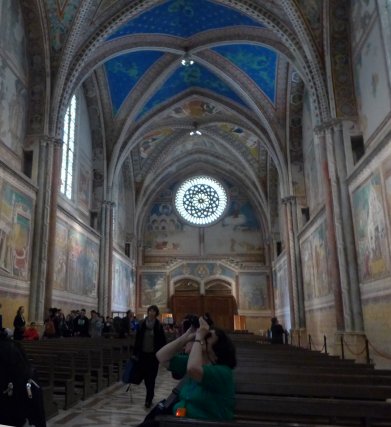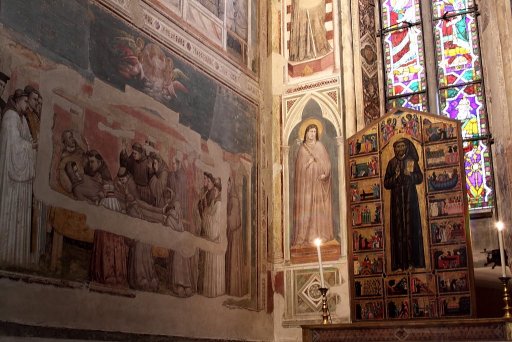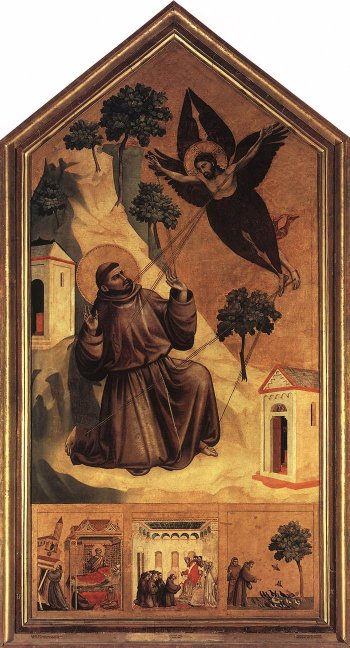According to Vasari (and many contemporary tour guides) the nave frescoes in the Upper Church of San Francesco, Assisi, are all by Giotto. Well, they're not: Giotto and the St Francis cycle in Assisi by Bruno Zanardi in The Cambridge guide to Giotto makes it clear that they were created by a team of artists, probably from Rome. There is little doubt, however, that he was aware of them, and was influenced by them. I am going to look at Franciscan images that are undoubtedly the work of Giotto, and put them side by side with the Assisi frescoes, looking for similarities and differences.
As suggested above, attribution is still an obsession with art historians. Medieval folk would have found this difficult to understand. The result can be that a number of important aspects of religious art can be overlooked, in particular the function of the artwork and its associated theology.
The Assisi frescoes
I have written extensively on these here, so my comments at this point will be brief.
Today these frescoes are a tourist attraction, but when they were created the public were not able to see them. Pilgrims visited the lower church only: the upper church was a chapter house reserved for the Franciscans. The narratives would have been familiar to them: what was important was the Franciscan theology, in particular the links between the life of Francis and Old and New Testament narratives that appeared above the St Francis cycle. In the view of the Franciscans, Francis was the Alter Christus, the second Christ.
The Bardi Chapel, Santa Croce, Florence.
Santa Croce is the main Franciscan church in Florence. Art historians agree that these frescoes are the work of Giotto and his team, though they do argue about when they were were painted.
This was a funeral chapel for the Bardi family. The fresco of Francis receiving the stigmata was at the entrance, visible to all, but as the chapel was a private one the other six frescoes would not have been so visible. The frescoes can be thought of as a condensed version of the Assisi frescoes, focusing on the most important events. Some frescoes attempt to cover two elements of the Assisi narratives. An important emphasis was on the death and ascension of Francis, appropriate for a funeral chapel.
The large altarpiece in the Bardi Chapel showing scenes from the life of St Francis is by Coppo di Marcovaldo, c 1240. It was moved here well after Giotto's day, but being a Florentine work, he was probably familiar with it. Click here for an image.

Upper church, San Francesco, Assisi

Bardi Chapel, Santa Croce, Florence
This was originally in the church of San Francesco, Pisa. It has generally been considered to be an altarpiece, perhaps in a side chapel, but in a paper by Donal Cooper, Redefining the Altarpiece in Early Renaissance Italy: Giotto's Stigmatization of Saint Francis and its Pisan Context (Art History) it is suggested that it was placed in a far more prominent position in the church. Unlike the frescos described above, this was very much public art. The message of the stigmatization, and three lower scenes, was the validity of the Franciscan message and the movement's place in society.
And so the purpose of the three artworks can be summed up in this way. The Assisi frescoes, theological; the Bardi Chapel frescoes, personal and meditative; and the stigmatization, a public celebration and justification of the Franciscan movement.

The Louvre, Paris
Page 3 St Francis before the sultan, The apparition at Arles
Page 4 Preaching to the birds
Page 5 Receiving the stigmata
Page 6 Death and ascension, The apparition of St Francis
Home page: explore the site